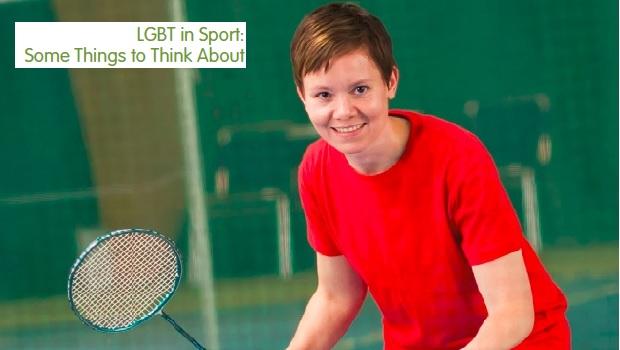Sport & physical activity at every level, from community to performance, has so much to offer people of all backgrounds including lesbian, gay, bi and trans (LGBT) people.

In all sports and activities, there are people who are out and open about their sexual orientation and gender identity and feel supported by their team, club and community.
However, many LGBT people continue to feel (and expect) that sport, particularly team sport, may not welcome them. They often feel that it’s best to keep that part of themselves private or worry that people might react badly if they find out.
“Gender stereotypes, bullying at school and a lack of visible LGBT role models create barriers which prevent young people and adults being themselves and trying new activities. For many people these barriers can be most intense when taking part in sport, whether it’s a school sports lesson or a university club.”
Ensuring LGBT people can take part in sport & physical activity is about building awareness and understanding around key areas. For example what language is and isn’t acceptable for staff, volunteers and participants to use.
Experiences of LGBT people in sport
âžœ 2/3 (68%) of lesbian, gay and bi school pupils say they don’t like team sport. (Stonewall Scotland)
➜ 41% of trans young people said that they would not join a sport club. (Metro Youth Chances Survey, 2014)
➜ 4 in 10 gay and bi men and 3 in 10 lesbian, gay and bi women would expect to experience homophobia if they participated in a team sport while being open about their sexual orientation. (Stonewall Scotland)
➜ Gay and bi men are 4 times less likely to take part in team sports than their heterosexual
What’s the problem?
There are common experiences that put LGBT people off taking part in sport or physical activity.
➜ Bullying at school.
➜ Gender stereotypes in sport.
âžœ Homophobic, biphobic, transphobic ‘banter’ in sport.
➜ Lack of visible role models.
Understanding these experiences can help your club or organisation to be more welcoming to LGBT people and champion inclusion more widely. Here is a link to find practical hints and tips:
➜ www.stonewallscotland.org.uk/our-work/campaigns/scotland-rainbow-laces
Stonewall is a charity that campaigns in schools, workplaces and communities across Britain to ensure that all lesbian, gay, bi and trans people can be themselves and participate fully in society. Stonewall provide a variety of Education and Community Resources to tackle homophobic, biphobic and transphobic bullying in education environments and help create more inclusive spaces.
LEAP Sports Scotland (Leadership, Equality and Active Participation in Sports for LGBTI people in Scotland) works for greater inclusion for LGBTI people in sport and against homophobia, biphobia and transphobia in a sports context. LEAP Sports Scotland has a packed programme of events, activities and projects to encourage more LGBTI people to try or get involved in sport. They also help by providing training, advice and resources. Including: Manifesto for Inclusive Physical Education
LGBT – Top Tips
➜ Ge support and involve senior coaches and managers.
➜ Use gender neutral language and avoid stereotypes about what is masculine or feminine behaviour.
âžœ Always challenge language, behaviour or ‘banter’ that is offensive to lesbian, gay, bi or trans people.
➜ Be approachable as a club and make the effort to find out more about local groups that offer support to LGBT people.
➜ Offer mixed teams and exercises where possible.
âžœ Be confident and positive about making sport open to everyone – mistakes may be made along the way, but remember you’re going in the right direction.
âžœ You can make LGBT issues more visible by using Stonewall Scotland’s posters and running campaigns like Rainbow Laces.
Find out more by clicking here: East Lothian's guide has been developed as a practical tool that assists individuals and organisations involved in delivering sport and physical activity opportunities to understand where to start when it comes to tackling inequalities.